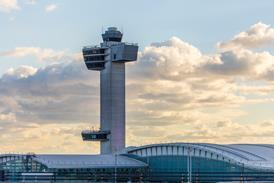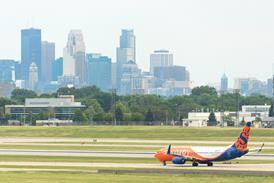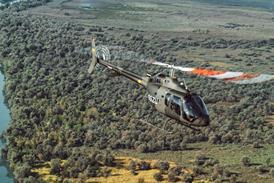Aerial firefighting companies have rushed aircraft to Southern California to battle a wind-whipped inferno that has burned neighbourhoods to the ground and that by some estimates could be the USA’s costliest blaze.
A diverse fleet of firefighting, surveillance and spotting aircraft are crisscrossing the skies above the Palisades Fire and other blazes burning north of Los Angeles.
Those aircraft include De Havilland Canada CL-series water bombers, Dash 8-400 fire-retardant-carrying tankers and Beechcraft King Air support aircraft. Several big-jet tankers are also on scene, including BAe 146s, a McDonnell Douglas MD-87 and the biggest gun of all, a DC-10.

“We sent out two more aircraft on contract today” to battle the Los Angeles fires – both Dash 8-400 tankers capable of carrying and releasing 10,001 litres (2,642USgal) of fire retardant, says Kelly Anthony, director of safety at Aero-Flite Aerial Firefighting, a Spokane, Washington company that operates 14 aircraft.
Those turboprops join three other Aero-Flite aircraft working the fires: an Avro International RJ85 tanker that can release 11,356 litres of retardant, and two CL-415 water bombers, which can fill their 6,136-litre tanks in 11sec when scooping from bodies of water. The company operates the fire-fighting fleet under contracts with the US Forest Service.
“The fire crews in the air and on the ground are working extremely hard in extremely challenging terrain and conditions,” says Kevin Condit, manager at Montana-based aerial firefighting firm Neptune Aviation Services.
Several fires are burning near Los Angeles, including the Palisades Fire, which has scorched 8,627 hectares (21,317 acres) and is only 8% contained as of late on 10 January, according to California fire agency Cal Fire. The fire has levelled Pacific Palisades and nearby areas and killed at least 10 people.
Condit says aerial firefighting conditions have been challenging due high winds, turbulence, hilly terrain and congestion in Los Angeles’ busy airspace.
Also “there are folks that want to send up their drone to view the devastation”, Condit adds.
A firefighting aircraft collided with a drone on 9 January, the Federal Aviation Administration says. The pilots landed safely. The FAA does not elaborate but warned drone operators they could face prison time and $75,000 fines for interfering with firefighting.
Neptune now has four aircraft working the Los Angeles fires: three BAe 146 tankers and a single “air attack” Aero Commander 690A.
“The Aero Commander operates like an air traffic controller above the fire and coordinates retardant drops with the team on the ground,” says Condit.
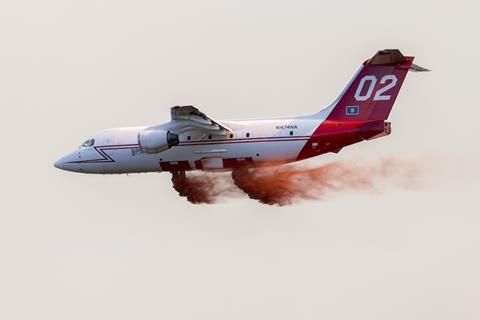
Sources say the Forest Service has largely been coordinating air operations, though the agency could not be reached for comment.
Historically, the North America wildfire season had been limited largely to summer and fall, though in recent decades the season has extended, driving demand for more firefighting aircraft, sources say.
“This was [our] first time fighting fires in the middle of January… We are basically a year-long operation” now, says Aero-Flite’s Anthony. Aero-Flite and parent Conair Aerial Firefighting are expanding, with plans to acquire at least two more Dash 8-400s, he adds.
Tankers are not the only types flying above the Palisades Fire.
On 7 January, Mississippi-based Tenax Aerospace got the go-ahead from customer Cal Fire to deploy one of its “fire-mapping” King Airs to the Los Angeles area. Next day, that aircraft started flying fire-surveillance missions high above the flames, says Tenax executive vice-president of business development Mark Levine.
The King Air carries a belly-mounted imaging suite that includes electro-optical and infrared sensors. Tenax pilots have been flying “box patterns” – often at night and at altitudes of 6,000-12,000ft – while collecting images that experts use to predict the fire’s spread, says Levine.
“We cover several hundred thousand acres an hour and detect up to six inches of hot coals,” he adds. “It basically gives you a high-resolution heat map of the fire. From that, you can build… prediction models.”
Additionally, Tenax supplies the Forest Service with 15 King Airs that the agency flies in tandem with tankers. The King Air pilots fly ahead of the tankers and use a smoke-marking system to identify drop spots.
Other aircraft flying above the Los Angeles fires include a DC-10 (N603AX) operated by 10 Tanker and an MD-87 (N297EA) flown by Oregon-based Erickson Aero Tanker, according to flight tracking website FlightRadar24.com. The DC-10 can unload about 35,600 litres of fire retardant and the MD-87 can release 11,356 litres.
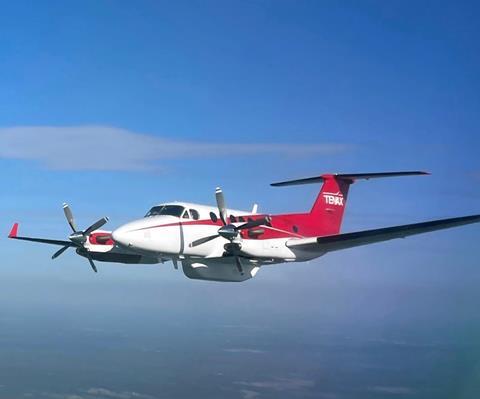
Cal Fire and the County of Los Angeles Fire Department also have aircraft flying above the flames, including Sikorsky S-70s and a North American OV-10A.
Many of the private aircraft are based at nearby airports in Lancaster and San Bernardino.
Condit says Neptune’s crews can be airborne within 15min of receiving dispatch orders. The missions typically last 15-30min, and the aircraft can be refilled and back in the sky after as little as 8min on the ground, he says.
In the last three days, Neptune’s crews have dropped more than 757,000 litres of fire retardant.
“It’s a well-oiled machine,” he says. “There are a lot of dedicated people working very hard to combat these wildfires.”


